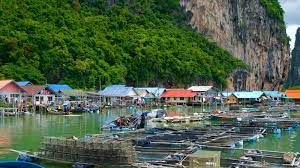
Source
When we talk about a city or a village, we are used to imagining an area with roads, cars, buildings. However, it turns out that there is another form of city or village that is rarely thought of, namely a floating village.
The floating village of Ko Panyi clearly doesn't fit the image of a city or village that people usually have in mind. The village is hidden in a bay in Southern Thailand and is protected by an enormous limestone rock formation about 20 meters high.
It would be easier to describe this village in a fantasy novel like the one by Italo Calvino. However, this village does exist with constructions emerging from the water supported by inclining stilts resembling the legs of a flamingo, housing more than 360 families and a total of 1,680 people.
Reported in Curve Everyday, Wednesday (27/1), the history of Ko Panyi begins at the end of the 18th century. People in Ko Panyi today used to follow a law that restricted land ownership to people from Thailand.
This prompted nomadic Malay fishermen to start settlements built on stilts, taking advantage of the calm and rich waters of the bay. With the increasing wealth of the people due to the thriving tourism industry in Thailand, it is now possible to buy land on the island itself.
They later built schools, health centers, and mosques. In Ko Panyi, nature sets the rules, and humans understand and obey them. When the tide is high and the waves are dangerous during the rainy season, they will emigrate from the village.
The history of Ko Panyi begins in the late 18th century.
The structural basis of Ko Panyi's house is built on stilts, and the houses are built with wood and bamboo. One of the main challenges of living on water is dealing with very limited hard surfaces, indicating a lack of common areas and gathering places.
Because of this, the residents of Ko Panyi are trying to collectively create a space for recreation and games. Inspired by the 1986 World Cup, a group of children decided to build a floating field, challenging the geographical challenges of the location.
The child starts working after school to finish the playing surface with wood, nails and a fishing raft. The field, which is 16 meters wide and 25 meters long, which is located next to the pier, has become a national treasure, although it has been replaced with a better one due to the great impact of the story.
According to the Malays, many other settlements were built on water. For example, on Lake Titicaca, Peru, where the pre-Inca Uru people lived on 42 floating islands made of totora, a thick, buoyant native reed that thrives in the shallow waters of the lake. Another example is the Amazonian village of Manaus, the capital of the Brazilian state of Amazonas where the foundation is built with wood from the Sandbox tree, which is very thick and water-resistant, serving as a floating device.
Ko Panyi is far from representing the future but still presents an alternative way of life in the community, respecting and understanding nature for what it is. This is an example that prompts us to realize how much we have to learn from different forms of settlement in addition to today's stereotyped patterns.
Reviewing and recognizing different forms of settlement, with their masters and cons is a very interesting exercise, especially in today's uncertain times full of social and environmental challenges.
It sounds like a good place to visit